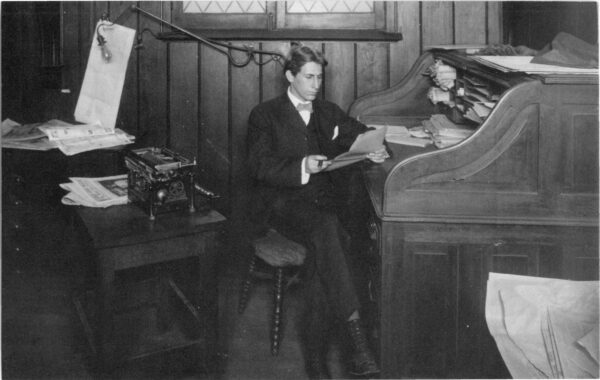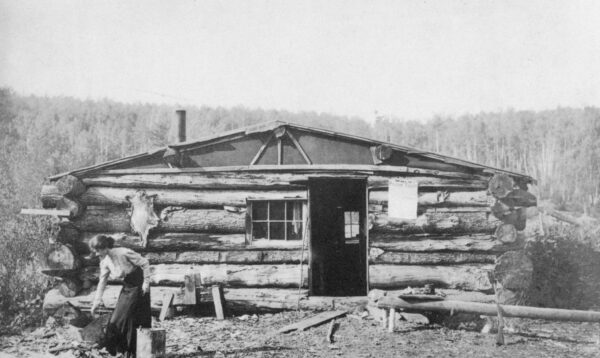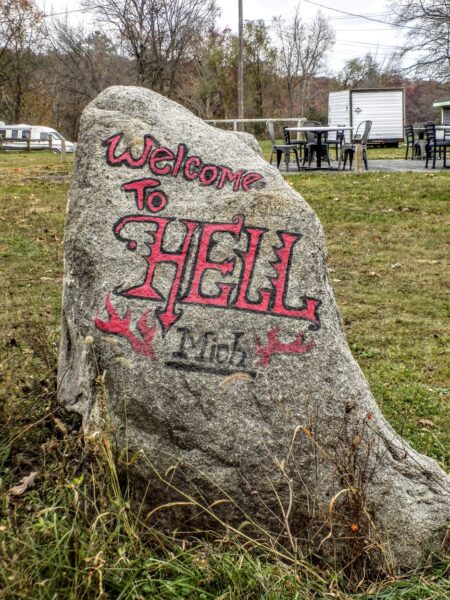After my Saint Louis photo-stop, I was off to Owosso about 30 miles south and 18 miles to the east. Since the Castle Museum in Saginaw had been closed, I had more free time to travel east – away from the day’s end point in Battle Creek. Owosso was the home of James Oliver Curwood a conservationist and immensely successful writer of adventure stories whose works have mostly faded from the popular consciousness.
The James Oliver Curwood story.
I suspect that if I asked most readers to name the title of a Jack London novel they’d likely respond quickly with either – White Fang, The Call of the Wild, or The Sea Wolf. If I repeated this exercise with James Oliver Curwood, I suspect I’d elicit little more than blank stares. Curwood, who was a contemporary of London’s, certainly achieved equal or greater fame during their lifetimes but is less remembered today. (It’s reported that at the time of his death in 1927 Curwood was the world’s highest paid author on a per word basis.)

[Photo of Curwood in 1907┬Ā from Owosso Historical Commission.]
One might say that James Curwood was born to be a writer. He started writing at age nine and published his first short story, The Terror of Athabasca, in 1894 at age sixteen. He spent some years writing for the Detroit Free Press and was, at one time, hired by the Canadian government to promote immigration and tourism in the western reaches of that nation – reportedly the only American entrusted with a project of this nature.
One can look to this IMDb page to find another measure of his fame and popularity. It lists a writer’s credit for Curwood on 206 film titles – many of which came posthumously. The first movie based on his work was a silent film called Looking Forward. It was released 20 December 1910 and has quite an interesting plot.
The 1949 film Kazan was based on Curwood’s 1914 novel of the same name. The plot, which seems possibly derivative of London’s White Fang, relates the story from the point of view of Kazan – a wolf-dog hybrid that escapes from a cruel owner and finds adventure and danger in the wild. Curwood’s approach to writing is probably summed up best by the statement seen in this photo.

The book sold more than 500,000 copies.
The most recent feature film based on a Curwood story called The Grizzly King was released in 1988 under the title of The Bear. The story seems to have been based, at least in part, on a critical incident from the writer’s life that changed both his worldview and his relationship with nature.
For Curwood, this turning point came on a 1914 hunting trip in the Canadian Rockies. As he recounted the story, he’d tried unsuccessfully on three separate occasions to shoot and kill a large bear he’d named Thor. At some point in one of his hunts, Curwood slipped, fell, and broke his gun. As he lay helpless on the ground, the massive bear reared menacingly above him but then walked away leaving Curwood unharmed.
From this point in his life, Curwood became a staunch opponent of trophy hunting and a zealous conservationist. The incident also gave rise to one of his most often cited quotes from The Grizzly King, “The greatest thrill is not to kill but to let live.”
You can find some of Curwood’s writing preserved by the Gutenberg Project. Here’s a link if you’re interested.
After a second stint with the Detroit Free Press, Curwood divorced his wife of eight years and returned to Owosso in 1908 where he built a home on West Williams Street. He remarried soon thereafter and his honeymoon with his second wife, Ethel, was essentially a camping trip to Hudson Bay where they lived in this cabin

[Photo from Owosso Historical Commission.]
for the first year. The pair continued their travels through Canada living in cabins they built themselves. Of this experience, Curwood wrote,
I have built with my own hands, this cabin which shelters me. My palms are still blistered by the helve of the ax. I am the architect of the fireplace of stone and mud in which a small fire burns for cheer, though it is late spring, with summer in the breath of the forests. I have made the chair in which I sit and the table on which I write, and the builder of a marble palace could take no greater pleasure in his achievement than have I.
As much as he thrived in the wilderness and drew inspiration for his writing there, Curwood was repeatedly drawn back to Owosso and would spend the last years of his life in his home town where he built what is called Curwood Castle. While he wasn’t personally involved in all aspects of the construction of the building, he did personally select and place the stones

adorning the exterior. Its construction required about a year and he wrote in a room in the turret on the far side of the castle overlooking the Shiawassee River.
The sharp-eyed among you should spot something in this photo that elated me – the small sign that reads Open. Hallelujah. I was so excited to find someplace open that when I told my story to Denise at the front desk, she asked if she could take my picture and feature me on their Facebook page. Obviously, I readily agreed.
A trip through Hell to reach Battle Creek.
First a confession. I didn’t have to go through Hell to get to Battle Creek from Owosso. In fact, I again had to deliberately choose to travel a few miles east before turning west to go to the day’s final destination. On the other hand, if you found yourself less than an hour’s drive from a town called Hell, wouldn’t you stop there?

How did the town gain it’s unique to the U S name? (There are, as far as I could discover, three other places worldwide named Hell. You can find one in Norway, one in the Netherlands, and one in the Cayman Islands.) According to the official gotohellmi website,
First settled in 1838 by George Reeves, Hell started out as a grist mill and general store on the banks of what is now called Hell Creek. GeorgeŌĆÖs habit of paying the local farmers for their grain with home distilled whiskey led many wives to comment ŌĆ£HeŌĆÖs gone to Hell againŌĆØ when questioned about their husbandŌĆÖs whereabouts during harvest time. ThE (sic) name stuck and ŌĆ£HellŌĆØ became an official town in 1841; the rest is history.
A story from August 2022 on Fox 17 fleshes the story out a bit more while also providing a slightly different spin,
The legend takes us to 1838. A man named George Reeves and his family purchased a saw mill on what’s now known as Hell Creek.
ŌĆ£A lot of times, horses would come home without riders, wagons without drivers,” said Colone. “Somebody had asked the wife, ‘You know, Where the hell’s your husband?’ The reply was always, ‘Gone to hell.'”
What started as a joke became a reality on October 13, 1841.
ŌĆ£When the state came by and asked George whether he was going to name his town, he said, ‘Call it Hell for all I care. Everybody else does,'” said Colone. “And it stuck.”
The town’s current owner, Jon Colone (quoted above) describes the community of 72 people as, “made up of Hellions, Hellbillies and Wannabies.” Perhaps the Wannabies think when they reach hell they’ll live a whole world of sin. They won’t.┬Ā Still, I felt right at home in a town where not only can one, among other things, purchase an inch of land or be mayor for the day for $100 but because, as you’ll see in the photos, there are puns galore.
After my visit to Hell, I set off for Battle Creek. I checked into the motel, and, after a lively exchange with the desk clerk took her list of recommendations and went to a nearby Japanese restaurant for dinner.┬Ā When I arrived at Kume, the menu, that included sushi, a hibachi grill, and a full menu of other Japanese and Japanese style dishes, looked a bit ambitious. Nevertheless, I ordered the Tofu Teriyaki dinner box and, while it was adequate, I was puzzled by their use of silken tofu rather than a firmer style that would have been considerably easier to pick up with chopsticks. I used a spoon. That’s all I have for now.
Meanwhile, you can see Hell’s puns together with my other photos in this photo album. Wednesday combines events accidental, predictable, and magical. See you then.
ŌĆ£A marriage that starts in Hell (Michigan) has no where to go but upŌĆØ
Now, why didn’t I think of that?